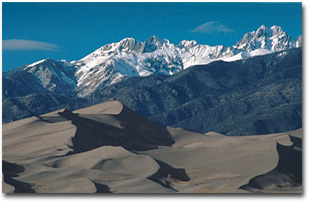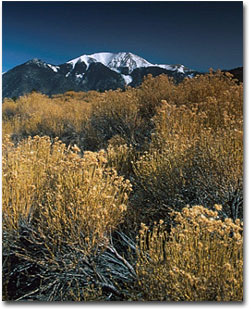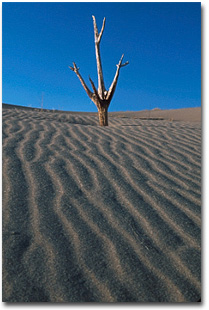 Nestled against the Sangre de Cristo Mountains in Southern Colorado's San Luis Valley, the Great Sand Dunes National Monument and Preserve stretches before you in a surrealistic dance of crests and troughs, light and shadow, confusing the mind and delighting the eye.
Nestled against the Sangre de Cristo Mountains in Southern Colorado's San Luis Valley, the Great Sand Dunes National Monument and Preserve stretches before you in a surrealistic dance of crests and troughs, light and shadow, confusing the mind and delighting the eye.
The dunes were formed over thousands of years as wind-blown sand grains from the banks of the nearby Rio Grande were deposited at the base of the mountains. The result of this slow but relentless geologic phenomena was the creation of the tallest dunes in North America (almost 750 ft. high along some of the ridges) and a huge, trackless sandbox covering almost 40 square miles. Add some snow-capped mountains as a backdrop, and you have the makings of an outstanding and unique photo destination.
The Big Picture
A good idea when you first arrive at the dunes is to take some landscape photographs from the road leading to the visitor center and parking lot. There are a number of pull-out points where you can park while composing your pictures. These are good spots from which to photograph the dunes with the Sangre de Cristo Mountains in the background. The best times to photograph the sand dunes-because of good light and cooler temperatures-are early morning and late afternoon, so plan accordingly. (The nearest town with all the conveniences, Alamosa, is about 30 miles away).
From the parking lot you simply head out onto the sand and hike around. There are no marked or designated trails on the dunes. The flat area surrounding the dunes is called the "sand sheet," and is relatively easy to walk on. It is also another good place for landscape work. However, keep in mind that as you get closer to the dunes, it becomes much harder to see the mountains until you crest High Dune, over 700 feet above the sand sheet.
Getting to the top of High Dune is not easy, especially while carrying a load of camera gear, food, and water (more on this later), but it is worth the effort. From here you will enjoy a spectacular view of the dunes below you, the Sangre de Cristos to the north, and the San Juans on the far side of the valley to the west. Catch your breath, set up your gear, and snap away.
For views of the dunes and mountains that include shrubs and trees, try the Little Medano Creek Trail along the east edge of the sand.
 Not Just One Subject
Not Just One Subject
But there is more to the sand dunes than expansive panoramas and eye-filling vistas. Although the dunes are a tough environment for any living thing, a few plants and animals do make their home here, and all make worthy photographic subjects.
Plants include blowout grass and Indian ricegrass; and in late summer you will also find bright yellow prairie sunflowers. Sand-dwelling animals include kangaroo rats and a few insects. If you're looking for bigger game like mule deer, elk, coyote, rabbits, and bobcats, look to the forests surrounding the dunes. Mosca Pass Trail, a well-marked path heading east from the dunes, is a great area for wildlife viewing and photographing. As usual, however, wildlife can be elusive, so be patient and do not intrude on the space of any animal you encounter. The trail leading up to Mosca Pass (and reaching above 10,000 ft.) starts near the visitor center and has its own parking lot.
For close-ups and abstracts, just look down. Thin grasses, sand ripples, and (if you're lucky) animal tracks, all make for pleasing, intimate portraits of this otherwise grand landscape.
Equipment
Sand and wind do not mix with anything photographic. Make sure you bring plenty of plastic bags to cover your gear. And to the extent possible, anticipate which lenses and filters you will be using in the field so you are not caught changing them during an unexpected sandstorm.
 Tripod placement and stability - or the lack thereof - is another constant problem when photographing on the sand dunes. I carry a small plastic tarp to sit or kneel on when photographing on snow or wet ground, and I've found it works fine as a tripod base as well. I simply place the tripod on top of the tarp to prevent its legs from sinking into the sand. For extra protection against camera shake, I also use a cable release. And if your camera has a mirror lock-up feature, you might want to engage it as well.
Tripod placement and stability - or the lack thereof - is another constant problem when photographing on the sand dunes. I carry a small plastic tarp to sit or kneel on when photographing on snow or wet ground, and I've found it works fine as a tripod base as well. I simply place the tripod on top of the tarp to prevent its legs from sinking into the sand. For extra protection against camera shake, I also use a cable release. And if your camera has a mirror lock-up feature, you might want to engage it as well.
Because most of the photographs you'll be taking will range from intimate to grand landscapes, I would suggest you bring lenses between 24mm and 200mm long. For adding definition to clouds, darkening skies, and eliminating reflections, consider using a polarizing filter. However, Colorado's electric-blue skies can turn almost black if too much polarization is used, so don't overdo it.
Take Care of Yourself
In the summer the surface of the Great Sand Dunes can reach 140 degrees Fahrenheit, hot enough to burn your feet. Thunderstorms can be severe here, so if you see one approaching get off the dunes or go to a low point to avoid lightning strikes. Trees or other natural shelters such as rocks are non-existent on the sand. What all this amounts to is you need to take care of the nut behind the camera when exploring the dunes.
First of all, be reasonably fit. Although outdoor photography, by its very nature, involves a fair amount of exercise, walking on sand dunes can be considerably more strenuous than hiking on firm ground. Pace yourself. Be aware that distances are deceiving. The top of a sand ridge is always father away than it looks. Wear a hat and sunscreen, and bring plenty of food and water, especially if you are planning on hiking beyond the first ridge of dunes (most people don't).
For more information about the Great Sand Dunes National Monument and Preserve, contact: Steve Chaney, Superintendent, Great Sand Dunes National Monument and Preserve, 11999 Highway 150, Mosca, CO 81146-9798; call (719)378-2312, extension 201; or visit www.nps.gov/grsa.
All Images - Canon EOS 3, EF 28-135/3.5-5.6 USM IS, Gitzo tripod, Fuji Velvia rated at ISO 40.
Editor's Note - Efraín M. Padró resides in Denver, Colorado and operates a part-time freelance writing/photography business called Padró Images.
Comments on this article? Send them to the editor.

